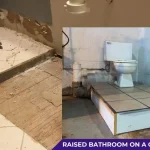Running ductwork between floor joists is a smart and space-efficient way to manage HVAC systems, especially in homes with limited room for traditional duct placement. This method allows ducts to be concealed within the structure of the home, improving both aesthetics and airflow. Understanding how to properly install ductwork between joists can make a significant difference in the efficiency of your heating and cooling system.
In this guide, we will walk you through the key aspects of installing ductwork between floor joists, including step-by-step instructions, common challenges, and expert tips. Whether you are a DIY enthusiast or considering professional help, this article provides the essential information you need to ensure a smooth and effective installation.
What Is Ductwork Between Floor Joists?
Ductwork between floor joists refers to the installation of HVAC ducts within the open spaces between the floor joists of a home. Floor joists are horizontal structural members that support the floors and ceilings of a building. By utilizing this space, ductwork can be run discreetly, without taking up additional room or requiring drop ceilings.
This method of duct installation is common in both new construction and retrofitting older homes. It is particularly useful in areas where space is limited or where preserving the aesthetic of a finished ceiling is important. Ducts installed between joists help distribute heated or cooled air efficiently throughout the home while staying hidden from view.
Benefits of Installing Ductwork Between Floor Joists
Installing ductwork between floor joists offers several advantages for homeowners and HVAC professionals. The strategic placement of ducts in this space can lead to improved efficiency, better use of available space, and enhanced system performance. Understanding the benefits of this installation method can help you make informed decisions when planning your HVAC system.
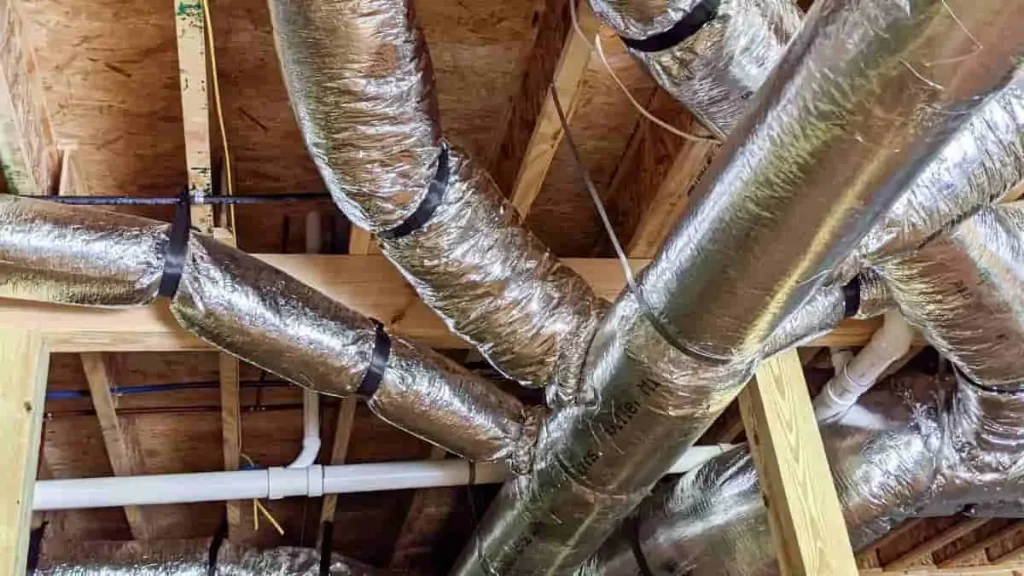
Space-Saving Design
One of the most significant benefits of running ductwork between floor joists is the efficient use of space. By utilizing the area between joists, you avoid the need for visible ductwork in living areas or basement ceilings. This not only preserves the aesthetics of the room but also allows for a cleaner, more streamlined design.
The hidden ductwork also frees up space for other home design elements, such as lighting, insulation, or ceiling treatments, and reduces the need for additional soffits or dropped ceilings that can take up valuable headroom.
Improved Air Distribution
When ductwork is installed between floor joists, it can create a more direct and efficient path for air distribution throughout the home. The placement within the joist cavities allows the ducts to run unobstructed from one room to another, minimizing the need for sharp bends or turns that can restrict airflow.
This direct routing results in improved air distribution, which can lead to better temperature regulation and more consistent heating and cooling throughout the house. By reducing air resistance and pressure losses, the HVAC system can operate more effectively, reducing the time and energy needed to achieve desired indoor temperatures.
Enhanced Energy Efficiency
Another key advantage of installing ductwork between floor joists is the potential for enhanced energy efficiency. When ducts are placed in an insulated or conditioned space, there is less chance of energy loss through heat transfer. Ducts located within the joist cavity are often surrounded by building materials that provide some level of insulation, helping to maintain the temperature of the air being circulated.
Additionally, properly sealed and insulated ducts between floor joists reduce the likelihood of air leaks, further improving the overall efficiency of the HVAC system. This can result in lower energy bills and reduced strain on heating and cooling equipment.
Protection from External Damage
Ducts installed between floor joists are better protected from potential damage compared to those that are exposed in attics, crawl spaces, or basements. The joist space acts as a natural barrier, shielding the ducts from physical harm caused by foot traffic, accidental bumps, or other impacts.
This added protection extends the lifespan of the ductwork, reducing the likelihood of costly repairs or replacements due to damage. It also helps to maintain the integrity of the ducts, ensuring that they continue to function properly and efficiently for years to come.
Noise Reduction
Running ductwork between floor joists can also contribute to noise reduction in your home. When ducts are placed in the joist cavity, they are surrounded by building materials that help to absorb sound. This can reduce the transmission of noise caused by the movement of air through the ducts, as well as minimize any rattling or vibration noises that can occur with exposed ducts.
As a result, you may experience quieter operation of your HVAC system, leading to a more comfortable and peaceful indoor environment.
Types of Ducts Suitable for Installation Between Floor Joists
Selecting the right type of duct for installation between floor joists is crucial to ensuring proper airflow and long-term system efficiency. The space between joists is often limited, so flexible and compact duct options tend to work best. Below are the different types of ducts suitable for this installation method, along with their pros and cons.
1. Flexible Ducts

Flexible ducts are one of the most common choices for installing between floor joists. Made from a wire coil covered with flexible plastic and insulation, these ducts can easily navigate tight or awkward spaces.
- Advantages: Flexible ducts are easy to install due to their bendability, making them ideal for routing through the often-narrow gaps between joists. Their flexibility allows for fewer cuts and connections, reducing the chances of air leakage.
- Disadvantages: While flexible ducts are convenient, they can be prone to sagging if not properly supported, which can reduce airflow. They may also be more susceptible to punctures or tears, especially if they are mishandled during installation.
Flexible ducts are best suited for short runs and areas with many bends or turns, provided they are properly secured to avoid airflow restrictions.
2. Rigid Ducts
Rigid ducts, typically made from sheet metal or galvanized steel, offer a durable and long-lasting solution for ductwork installation between floor joists. These ducts maintain their shape and do not sag or bend.
- Advantages: Rigid ducts provide superior airflow since they retain their shape, allowing air to move freely without obstruction. They are also highly durable, resistant to damage, and less likely to develop leaks compared to flexible ducts.
- Disadvantages: Installing rigid ducts between joists can be more challenging because they do not bend, requiring more precise planning and cutting. They also take up more space, which may be an issue in areas with limited joist height.
Rigid ducts are ideal for long, straight runs where durability and airflow efficiency are a priority.
3. Semi-Rigid Ducts
Semi-rigid ducts combine some of the flexibility of flexible ducts with the durability of rigid ducts. These ducts are typically made from aluminum or other flexible metals, offering a compromise between flexibility and strength.
- Advantages: Semi-rigid ducts are easier to install than rigid ducts but more durable than flexible ducts. They can be shaped to fit within joist spaces without compromising airflow efficiency, and they are more resistant to punctures than traditional flexible ducts.
- Disadvantages: Although semi-rigid ducts are more flexible than rigid ones, they still require careful handling during installation to avoid kinks or bends that could restrict airflow.
Semi-rigid ducts are a great option for areas where a balance between durability and flexibility is needed.
4. Oval Ducts
Oval ducts are designed specifically for installation in confined spaces like floor joists. Unlike traditional round or rectangular ducts, oval ducts have a flatter shape, allowing them to fit more easily within narrow joist spaces.
- Advantages: Oval ducts provide an efficient airflow solution while occupying less vertical space. Their flattened shape makes them ideal for fitting into tight spaces without compromising airflow. They are often made from metal, providing good durability.
- Disadvantages: Oval ducts may be more expensive than standard duct options and may require custom fittings or connectors for proper installation. Additionally, they can be more challenging to find in certain markets.
Oval ducts are highly effective for installations where space is a primary concern and airflow efficiency is still required.
5. Insulated Ducts
Insulated ducts come with a layer of insulation wrapped around the exterior to help regulate the temperature of the air passing through. This is particularly important when running ducts through unconditioned spaces, such as between floor joists that separate floors from basements or attics.
- Advantages: Insulated ducts help prevent energy loss by reducing temperature fluctuations in the air being distributed. This improves the overall efficiency of the HVAC system and keeps heating and cooling costs down.
- Disadvantages: Insulated ducts are often bulkier than non-insulated options, which can make them harder to fit between tightly spaced joists. They may also require extra care during installation to avoid damaging the insulation layer.
Insulated ducts are ideal for installations where maintaining air temperature and energy efficiency is a priority.
How to Run Ductwork Between Floor Joists
Running ductwork between floor joists requires careful planning and execution to ensure proper airflow and efficiency. The process involves measuring, cutting, and installing ducts within the joist spaces while avoiding structural or system issues. Below are the detailed steps and key considerations.
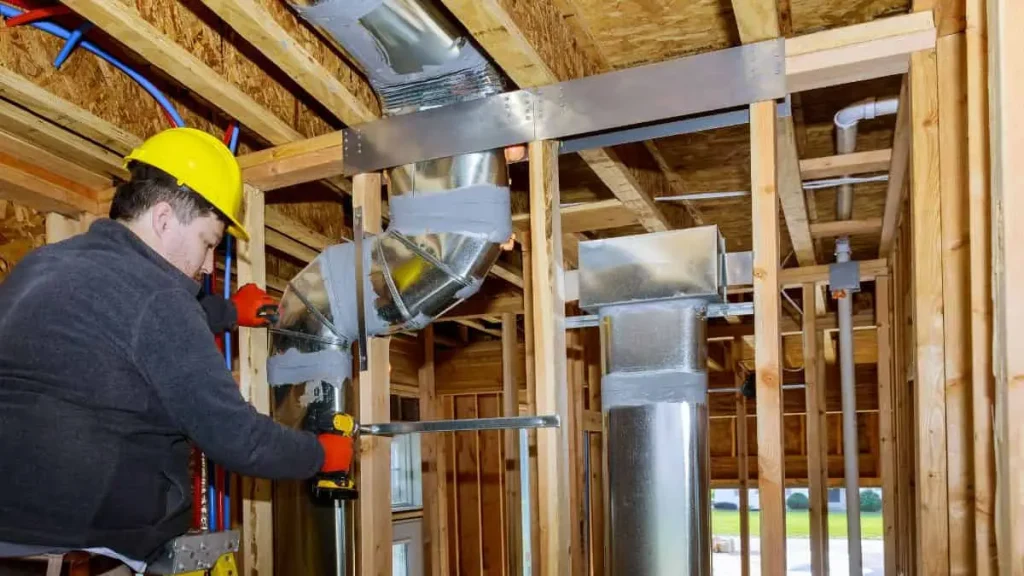
Measure and Plan the Duct Route
Before installing ductwork, the first step is to measure the available space between the floor joists and plan the route. Here’s how to approach this:
- Determine the duct path: Identify the path where the ductwork will run from the HVAC system to the necessary rooms.
- Measure joist spacing: Most standard joists are spaced 16 or 24 inches apart. Ensure the ducts will fit within this space.
- Mark obstacles: Take note of plumbing, electrical wiring, and other obstructions that might interfere with the duct installation.
- Plan access points: Plan where you will need access for vents or registers in each room.
Proper measurement and planning are critical to avoiding errors that can lead to inefficient airflow or future repairs.
Cut Duct Holes and Openings
Once the duct route is planned, the next step is to cut holes in the joist spaces to accommodate the ducts:
- Mark cutting points: Use your measurements to mark the exact locations where ducts will pass through joists, subflooring, or walls.
- Choose the right tools: A reciprocating saw or hole saw is typically used for cutting through wood or subflooring.
- Cut carefully: Make precise cuts to ensure a tight fit. Avoid cutting into any structural elements like joist beams or electrical systems.
Cutting clean and accurate openings will ensure the ductwork fits properly and minimizes air leaks.
Install the Ducts
After the holes are cut, the next phase involves installing the actual ductwork between the joists:
- Insert the ducts: Place the ducts into the open joist spaces, ensuring they are aligned with the previously cut openings.
- Secure the ducts: Use metal straps or brackets to hold the ducts in place. Secure them to the joists, ensuring the ductwork is stable and does not sag.
- Seal the joints: Apply HVAC foil tape or mastic to seal any duct joints and connections, preventing air leaks.
Connect the Ducts to Vents and Registers
Once the ducts are in place, they need to be connected to the vents and registers that will deliver air into each room:
- Cut vent openings: Use a saw to cut openings in the subflooring or drywall where the vents will be installed.
- Install vent boots: Attach vent boots to the ductwork and secure them to the framing or subfloor.
- Connect vents: Attach the vents or registers to the boots, ensuring they are flush with the surface and securely fastened.
Connecting ducts to properly placed vents ensures that air flows evenly throughout the space.
Test for Airflow and Leaks
Once the installation is complete, it’s essential to test the system for airflow and ensure there are no leaks:
- Turn on the HVAC system: Run the heating or cooling system and check each vent for strong airflow.
- Check for leaks: Use a smoke pencil or soapy water to identify any leaks at the duct joints or connections.
- Fix issues: If there are leaks or weak airflow, reseal the ducts or adjust the connections to improve performance.
Testing the system after installation ensures it is functioning correctly and efficiently distributes air throughout the home.
Recommended: Running Romex Through Floor Joists
Installation Tips for Ductwork Between Floor Joists
Successfully installing ductwork between floor joists requires careful planning, the right materials, and attention to detail. This section will cover essential tips to ensure a smooth installation process and maximize the performance of your HVAC system.
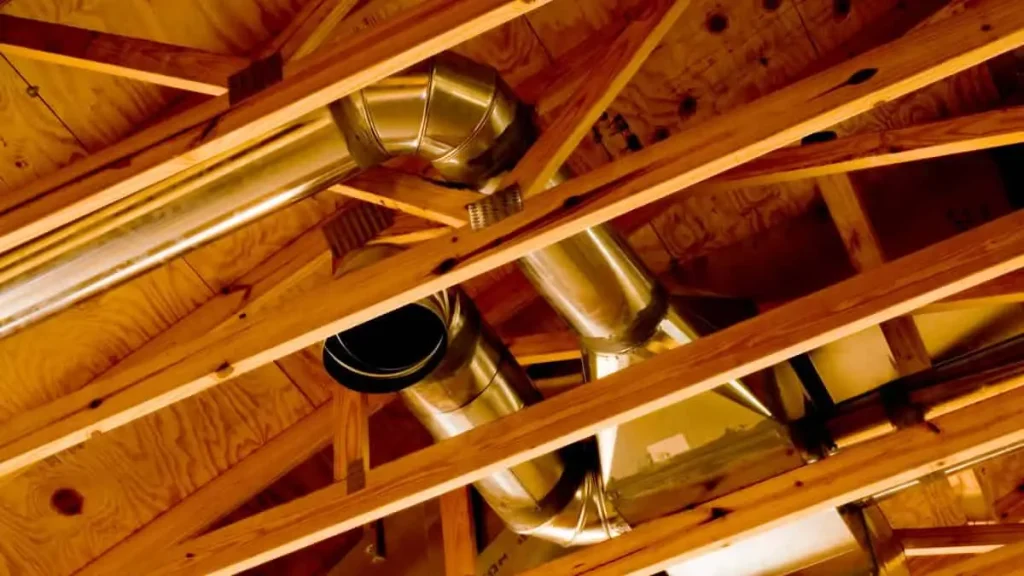
Measure the Space Accurately
Before starting the installation, it’s crucial to measure the space between the floor joists. Joists in homes typically range from 16 to 24 inches apart, so confirming the exact spacing is necessary to determine the appropriate duct size. Measurements should include not only the width between joists but also the height available, as this can impact your choice of duct type.
Accurate measurements help you avoid the mistake of purchasing ductwork that is too large to fit the space. For more confined areas, oval or flat ducts may be necessary, as they can maximize airflow without occupying too much vertical space.
Pre-Plan the Route
When installing ductwork between floor joists, it’s essential to pre-plan the route the ducts will take. This includes identifying the start and end points, any required bends, and the location of vents. Ensure that the ducts run in a straight line as much as possible to reduce airflow restrictions. If turns are necessary, using long, sweeping curves rather than sharp angles will help maintain airflow efficiency.
Additionally, avoid routing ducts near electrical wiring, plumbing, or other obstructions that could cause issues during installation or maintenance.
Related Read: How to Reinforce Floor Joists for Plumbing
Secure the Ducts Properly
To prevent sagging or misalignment, all ducts installed between floor joists must be securely fastened. Using metal hangers or straps ensures that the ducts remain in place, which is particularly important when dealing with flexible ductwork that can droop over time. Proper securing not only ensures that the ducts stay aligned but also helps maintain even airflow.
For rigid ducts, brackets can be installed to anchor the ducts to the joists. This will prevent them from moving due to vibration from the HVAC system or other structural shifts.
Insulate for Efficiency
Insulating the ductwork is a key consideration, especially if the ducts are running through unconditioned spaces. Insulation prevents heat loss or gain, ensuring that the air being delivered stays at the desired temperature. Even when ducts are placed between floor joists within conditioned spaces, insulating them can still help maintain system efficiency by reducing temperature fluctuations.
When choosing insulation, make sure to select materials that are appropriate for the type of duct being installed. Flexible ducts may already come with pre-attached insulation, but rigid or semi-rigid ducts will require additional insulation wrapping during installation.
Seal All Connections
Sealing duct joints and connections is a critical step in preventing air leakage, which can drastically reduce the efficiency of an HVAC system. Use mastic sealant or metal foil tape to seal all joints securely. Avoid using standard duct tape, as it can degrade over time, leading to leaks.
Common Challenges and How to Overcome Them
While installing ductwork between floor joists can be efficient and space-saving, it comes with several challenges. Knowing these issues in advance and understanding how to address them can make the process much smoother.
Limited Space Between Joists
One of the most frequent challenges is working with the limited space between floor joists, especially in older homes where joists may be closer together. This can make it difficult to install standard round or rectangular ducts without modification.
To overcome this, you can opt for flexible, semi-rigid, or oval ducts that fit more easily within narrow spaces. In some cases, custom-cut ducting may be necessary to ensure a proper fit. Planning the duct route carefully and using every inch of available space can also help.
Sagging Flexible Ducts
Flexible ducts, while easier to install in tight spaces, can sag over time if not properly supported. This sagging can restrict airflow and reduce the overall efficiency of the HVAC system.
To prevent this, it’s important to install metal straps or hangers every few feet to keep the ductwork securely in place. Ensuring that the ducts are pulled taut during installation can also help minimize the risk of future sagging.
Navigating Obstacles
Obstacles such as plumbing, electrical wiring, and other structural elements can pose significant challenges during installation. These obstructions can make it difficult to run ductwork in a straight line or force installers to use more bends and turns than initially planned.
When encountering obstacles, it’s essential to either re-route the duct around them or consider adjusting the position of vents and other system components. For small obstructions, consider using flexible ducting, which can snake around barriers more easily than rigid ductwork. However, try to avoid too many sharp bends, as this can restrict airflow.
Maintaining Proper Airflow
Maintaining proper airflow is critical to the effectiveness of any ductwork system. However, ducts installed between floor joists often have to navigate multiple bends and tight spaces, which can lead to reduced airflow if not carefully managed.
To overcome this, it’s essential to use long-radius elbows for turns, as they cause less resistance than sharp bends. Ensuring that ducts are appropriately sized for the airflow needed is also key—using ducts that are too small can choke off airflow, while oversized ducts may result in inefficient air distribution.
Ensuring Adequate Insulation
A common issue is the lack of adequate insulation, particularly when ducts run through unconditioned spaces, such as basements or attics. Without proper insulation, conditioned air can lose heat in the winter or gain heat in the summer, reducing overall system efficiency.
To address this, always insulate ductwork when necessary, even if the space between the floor joists is already conditioned. For flexible ducts, pre-insulated options can simplify the installation process. For rigid or semi-rigid ducts, apply insulation wrap during installation and ensure all seams are sealed.
Air Leaks at Connections
Air leaks are a common issue in duct installations, especially when ducts are run between joists, where access can be limited. Leaks can lead to significant energy loss and reduced system performance.
To prevent this, make sure all duct connections are tightly sealed with mastic or metal foil tape. Regularly inspect the ductwork for signs of leakage and re-seal any areas where leaks may have developed. This step is crucial to ensuring the long-term efficiency of the HVAC system.
Best Practices for Maintaining Proper Airflow
Maintaining proper airflow is critical to ensuring that your HVAC system operates efficiently and effectively. When installing ductwork between floor joists, there are several best practices to follow to optimize airflow and avoid issues like pressure drops or uneven heating and cooling.
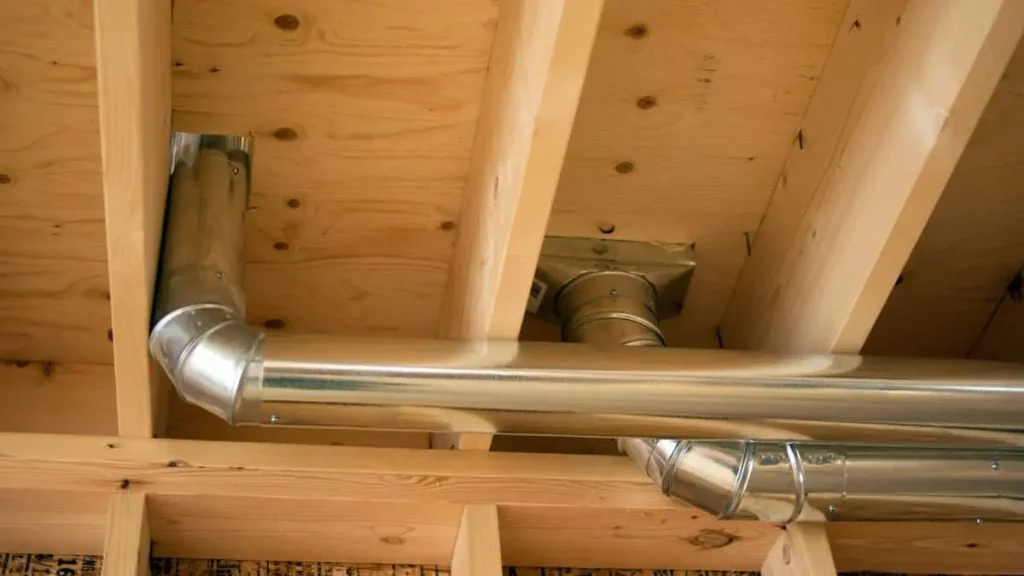
Ensure Duct Sizing Matches System Requirements
One of the most important aspects of maintaining proper airflow is ensuring that the duct size matches the requirements of your HVAC system. Undersized ducts can restrict airflow, causing the system to work harder and reducing its overall efficiency. Oversized ducts, on the other hand, can lead to uneven air distribution, resulting in hot and cold spots throughout the home.
Before installation, it is essential to perform load calculations to determine the appropriate duct size for each area of the house. Consulting with an HVAC professional or using duct sizing software can help ensure that the ducts are properly sized for optimal airflow.
Minimize the Number of Bends and Elbows
Sharp bends and elbows in ductwork can significantly reduce airflow by increasing resistance within the ducts. To maintain proper airflow, it is important to minimize the number of bends and turns in the ductwork. Where bends are necessary, long-radius elbows should be used to reduce resistance and allow air to flow more freely.
Careful planning of the ductwork layout, including selecting the most direct route between the HVAC system and the supply registers, can help minimize the need for unnecessary bends.
Proper Sealing of Duct Joints and Connections
Air leaks at duct joints and connections are a common cause of airflow issues in HVAC systems. To maintain proper airflow, it is crucial to seal all duct joints, seams, and connections with a high-quality sealant, such as mastic or metal foil tape. These materials create an airtight seal that prevents conditioned air from escaping into the surrounding joist cavities.
Insulate Ducts to Prevent Heat Loss or Gain
Proper insulation of ducts running between floor joists is essential for maintaining consistent airflow and temperature. Without adequate insulation, ducts are susceptible to heat loss or gain, which can affect the temperature of the air moving through the system and reduce overall efficiency.
Installing insulation around the ducts helps to maintain the desired air temperature and prevents energy loss. This is especially important for ducts that pass through unconditioned spaces, such as basements or crawl spaces, where temperature fluctuations can impact the performance of the HVAC system.
Regular Inspection and Maintenance
Even with proper installation, it is important to regularly inspect and maintain your ductwork to ensure optimal airflow. Over time, dust, debris, and other contaminants can build up inside the ducts, obstructing airflow and reducing system efficiency. Periodic cleaning of the ducts helps to remove these obstructions and restore proper airflow.
In addition, regular inspection of the duct joints and connections is essential to check for any signs of leaks or damage. Addressing these issues promptly helps to prevent further airflow restrictions and ensures that your HVAC system continues to operate at peak performance.
Conclusion
Installing ductwork between floor joists offers a space-saving and efficient solution for HVAC systems in both residential and commercial buildings. By understanding the process of running ducts in this often-overlooked area, selecting the appropriate types of ducts, and following best practices for installation, you can ensure optimal air distribution and energy efficiency.
Avoiding common mistakes, overcoming challenges, and utilizing proper insulation are crucial steps in maintaining the longevity and performance of your ductwork. Regular maintenance and attention to airflow management will further enhance the overall comfort and functionality of your HVAC system, making duct installation between floor joists a reliable and effective choice.



